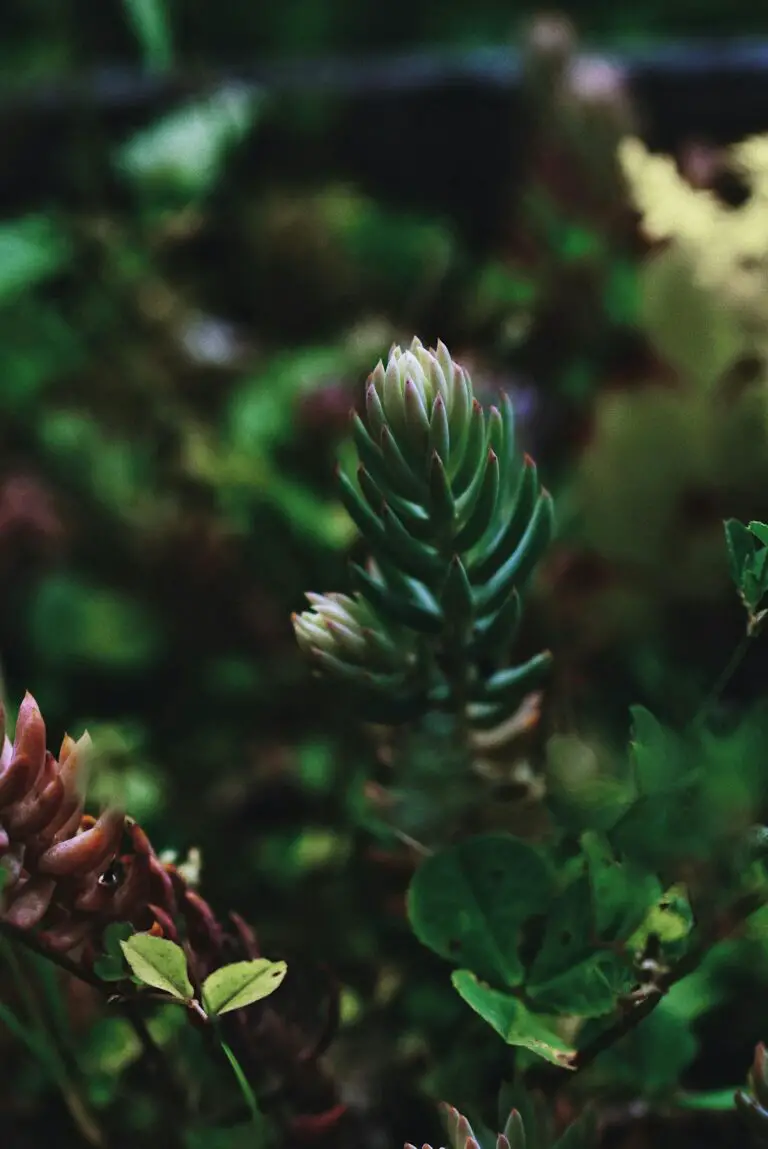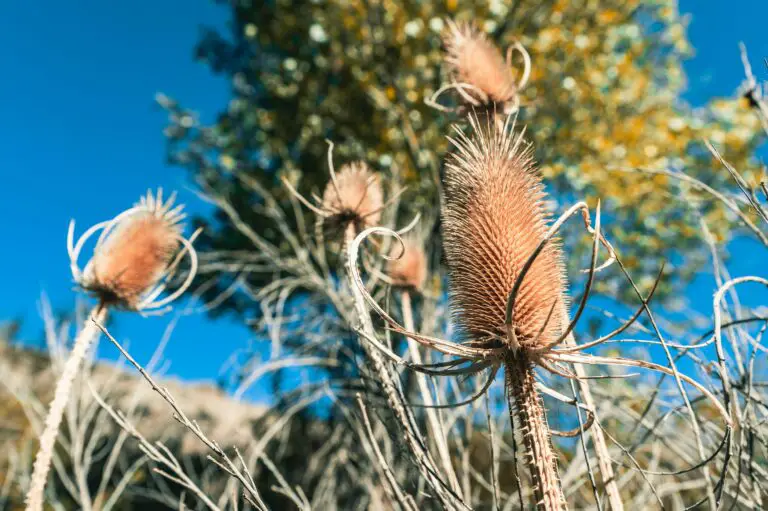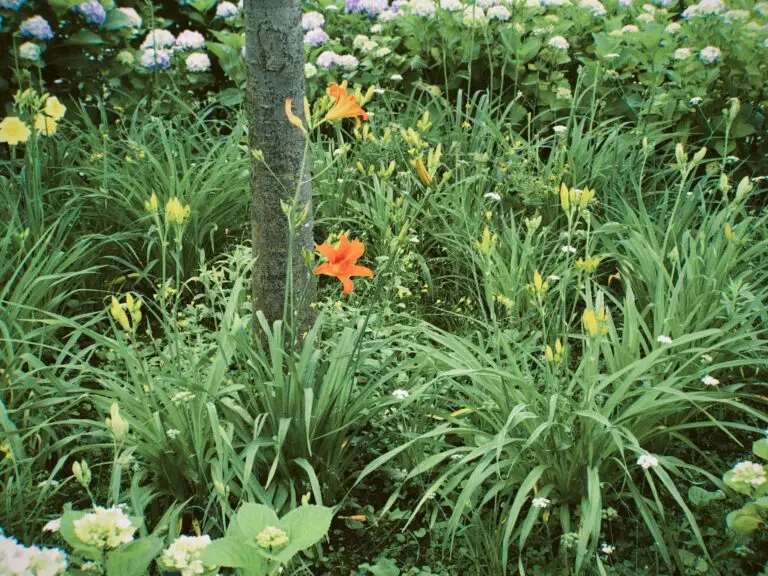Introduction to Sedum: A Succulent Superstar
Explore the world of sedum, a versatile and hardy succulent beloved by gardeners for its ease of care and aesthetic appeal. Picture this: a lush carpet of jade green, dappled with star-shaped blooms, cascading over a stone wall in a garden that’s alive with color and texture. That’s the allure of sedum – a true gem among succulents that offers an array of types, each one with its unique charm.
Consider Sedum Adolphi, commonly known as Golden Sedum. It’s a radiant beacon with leaves that capture the sunlight, turning it into a golden treasure in your garden. This real-life example attests to the resilience and beauty of sedums, demonstrating their ability to thrive with minimal fuss.
In the quest for creating that perfect succulent landscape, sedum stands out as a go-to choice for both novice and expert gardeners. It’s the plant that invites a second glance, with its alluring forms and easy-going nature. Let’s dive into its world and uncover the secrets to making these succulent superstars the cornerstone of your green haven.
And for those eager to jumpstart their sedum journey, take inspiration from this comprehensive video:
Unveiling Sedum’s Ideal Growing Conditions
Imagine a plant that’s as tough as it is beautiful, thriving in those sunny spots in your garden where others might wither away. Enter Sedum, the versatile succulent that’s as resilient as it is elegant. But don’t be fooled by its hardy nature; creating the perfect environment is key to a display of lush, vibrant succulents that can turn any novice gardener into a green-thumbed wizard.
The ideal climate for Sedum is one that echoes their native rugged landscapes—think bright, unfiltered sunlight and the heat radiating from a rock garden. These succulents are the epitome of sun worshippers, and with the right amount of light, they reward you with a spectacular show of color and form. Too much shade, and your Sedum might look a little lackluster, stretching towards the light in a phenomenon known as etiolation.
When it comes to soil, Sedum plants are as low-maintenance as they come, but there is one golden rule: It must be well-draining. Picture the rocky cliffs and ancient ruins where Sedum naturally flourishes; that’s the type of drainage we’re aiming for in your garden. An abundance of organic material is not their cup of tea; instead, Sedum thrives in lean, sandy, or gravelly soils that mimic their natural habitats. Contemplate the soil requirements of stonecrops to replicate that perfect balance.
Watering your Sedum can be a bit of an art form. They’re much like the camels of the plant world, storing water in their fleshy leaves and stems to carry them through dry spells. This means they’re not fans of soggy soil, which can lead to root rot. If you’ve ever struggled with keeping plants alive, Sedum might just be your match with its ‘less is more’ approach to hydration.
You don’t need to take my word for it — here’s a video that dives into the wonders of growing Sedum and how you can get the most out of these robust plants:
For more detailed tips on nurturing your garden companions, take a stroll through the comprehensive guide on cultivating your succulent garden. You’ll discover the secrets to creating your very own Sedum sanctuary.
Remember, even though Sedum plants seem tough, they still crave that tender love and care only a devoted gardener can provide. With these grow-how tips, you’re well on your way to basking in the glory of thriving Sedum that will make your neighbors green with envy.
Soil Secrets for Spectacular Sedum Growth
Let’s talk terra firma, specifically the dirt on what makes sedum smile. Imagine you’re crafting a gourmet meal for a treasured guest – that’s your approach to mixing the ultimate soil for sedum, the unassuming yet fabulous fleur-de-rock! This resilient succulent is not persnickety, but it will flourish with your TLC through the right soil concoction.
Now, you might wonder, “What’s sedum’s secret sauce for soil?” Picture this: a blend that’s as light and crumbly as your favorite shortbread cookie, allowing roots to breathe and moisture to drain faster than a hiccup. That’s the dreamy dirt sedum salivates for! Ponder the well-being of these little green gems when selecting a soil mix. Too much moisture is the nemesis of these drought-loving darlings.
The best soil mixtures mimic the rugged, airy habitats that these plump-leafed plants pivot towards. We’re shooting for a happy medium, which calls for some elbow grease and a pinch of know-how. Envision a layered lasagna of gravel, sand, and compost. That’s your ticket to gripping roots and preventing soggy bottoms, ensuring a sturdy base that outlasts even the most topsy-turvy weather.
Remember, sedum is the mountain goat of the plant kingdom, scaling sharp inclines with poise. To mirror these slopes at home, strike a balance by augmenting your garden gold – that’s your soil – with materials that promote drainage. Cue the perlite, coarse sand, and fine pumice, all featherweights in their division but heavy-hitters for soil porosity. Dive deeper into these hardy plant habitats to appreciate their preference for such terrain.
One last tip from the plant whisperers: variate your variants! No two sedum are exactly alike, and across the spectrum from Sedum acre to Sedum spectabile, preferences can vary. For customized care, consider conjuring up a soil mix that caters to your particular variety’s whims. It’s a small step for a gardener, but a giant leap for plant-kind!

The Influence of Climate and Sunlight on Sedum
Succulent enthusiasts, unite! Ever wonder why your sedum sometimes resemble the lush, emerald stars of a rock garden and other times look as wilted as last week’s lettuce? Well, it all comes down to climate and sunlight – the twin conductors of the sedum symphony. But fear not; we’re here to attune your green thumb to the perfect pitch for your sedum to truly thrive.

Picture this: a sun-drenched hillside, the air just the right mix of warm and breezy. Your sedum are basking in that glow like vacationers in the Mediterranean. They love the sun almost as much as sunbathers do! But it’s not just about being sun-kissed. These hardy plants require a precise recipe of light and heat to unlock their potential. Aim for that sweet spot of around 6 hours of natural light, and watch your sedums turn into the botanical equivalent of a sun-soaked Instagram model.
Now, let’s chat climate. Sedum are no strangers to playing it cool. They’re versatile like that trendy jacket you can wear in any season. Whether they’re weathering the heat of the Arizona desert or chilling in the brisk air of a New England autumn, sedum know how to adapt. They shrug off drought like a pro, but they’re not fans of boggy, waterlogged soils. Think of them as the all-terrain vehicles of the plant world; they can handle a range of environments as long as their roots aren’t swimming in excess moisture.
Adapting to local conditions is the key. If you’re living in an area that’s more “tropical paradise” than “temperate zone,” you might need to provide a bit of shade to prevent your sedum from getting sunburned. Yes, plants get sunburned too! It’s all about balancing their love for the light with the need to protect those succulent leaves from getting crispy.
Last but not least, location, location, location! The secret to your sedum’s success? Finding the perfect spot where they can flourish. Maybe that’s a rooftop garden in Brooklyn, a sunny alpine ledge in the Rockies, or a quaint little flower bed in your suburban backyard. Wherever it is, make sure it’s a place where the climate complements their sunbathing habits, and you’ll soon have the stuff of garden legends.
Mastering the Art of Watering Sedum
One might think watering plants is as simple as pouring some H2O and calling it a day, but sedum specimens beg to differ! These hardy succulents are drought-tolerant wonders, making them the ideal plant for those inclined to forget the watering can now and then. However, understanding the balance between drought endurance and hydration necessity is crucial to their success.
Imagine, if you will, a Sunday morning; the sun is just beginning to cast its warm, golden rays over your garden. This is the perfect scene to engage in the craft of watering your sedum. The early hours provide a sweet spot, ensuring that the water you pour does not evaporate instantly but is absorbed steadily into the soil, granting your green friends the moisture they crave.
No more water guesswork—you’ve got science on your side now! Your sedum doesn’t fancy having its ‘feet’ wet continuously, so a thorough drink followed by a period of drought is akin to a spa day for them. Think of it like a feast followed by a fast—a sumptuous soaking, then nothing until the soil is dry. To test their thirst level, stick your finger a couple of inches into the ground. Is it dry? It’s watering time!
Of course, not everyone has a garden where sedum can stretch its roots. If you are a city dweller with potted sedum playing the role of the green oasis on your balcony, here’s an urban hack: lift the pot. Feels lighter than usual? Your cue to quench its thirst. Remember though, much like the best cocktails, drainage is key! No one enjoys a waterlogged pot.
And for those in more arid climates or forgetful gardeners, real-life succulent success stories often come down to one thing: adaptation. There once was a sedum in Arizona, named Spartacus by its doting owner. Spartacus relished in the infrequent but plentiful waterings, rising to become the talk of the town (or at least the neighborhood). Be like Spartacus’ owner; know when to hold back and when to flood your sedum with love and, more importantly, water.

Behind the seemingly low-maintenance sedum facade lies a challenge that rewards those who take the time to understand their needs. Now that you’re in the know, watch your sedums thrive, turning neighbors green with envy as your robust specimens prove that you, indeed, have mastered the art of watering sedum.
Preventing Pests and Diseases in Sedum
Imagine you’re on a mission, a green-thumbed guardian tasked with shielding the vibrant, fleshy leaves of your sedum plants from tiny, unwanted invaders. It’s a vital role because, let’s be honest, who wouldn’t want their succulents to thrive in peak condition? Like a fortress, your garden is to be fortified, and here’s how to keep those pesky pests and diseases at bay.
Firstly, let’s chat about those munching marauders – aphids and mealybugs. These critters adore making a meal of your sedum’s sap, but you’re not running an all-you-can-eat buffet. To nip the problem in the bud (quite literally), encourage natural predators like ladybugs into your garden. Think of them as your loyal knights, bravely defending your sedum kingdom. They’re not just pretty faces; they’re voracious pest-eaters.
Nipping over to diseases, sedum can succumb to the likes of rot when conditions get all soggy and somber. The secret to prevention? It’s all about the vibe… the air vibe! Ensuring good air circulation keeps the atmosphere around your sedums drier, making it less welcoming for fungal spores. Create some breathing room by spacing your plants and giving them that sweet, sweet air they love.
Now, remember our mission? It’s a balance – water your sedums, but don’t drown them in affection. Overwatering is a cardinal sin in the succulent world, and sedum is no exception. By keeping things on the drier side, you’re essentially telling any potential diseases, “No room at the inn!” So, grab that watering can, but wield it wisely.
In the quest for sturdy sedums, cleanliness is your trusty steed. Keep dead leaves and debris out of the picture, as these can harbor fungi and insects looking for a free ride. Regularly inspecting your plants for signs of trouble and acting swiftly means diseases won’t stand a chance to throw a coup in your plant kingdom.
So there you have it, your blueprint for fortifying your sedum plants against the onslaught of pests and diseases. With vigilance, care, and a dash of wisdom, your succulents will remain robust, resilient, and regally beautiful.
Propagation and Planting: Expanding Your Sedum Sanctuary
Calling all green thumbs and succulent savants! Have you ever marveled at the resilience of sedum plants? These robust beauties are not just about rugged looks; they carry a secret superpower – the ability to clone themselves! That’s right, with a few simple steps, you can create an entire garden from just a handful of leaves. Let’s dive into the world of sedum propagation and learn how to get your garden bursting with these versatile succulents.
Picture this: a single sedum leaf, fallen to the ground, begins its journey to become a whole new plant. This isn’t a magic trick; it’s the natural ability of sedum to propagate from cuttings or leaves. Imagine taking a few snips from your robust mother plant and watching as they root and form their own identities. To start, choose a healthy sedum and gently twist off the leaves from the bottom up, ensuring a clean break.

Next, patience is a virtue. Lay your sedum leaves on well-draining soil and refrain from the urge to water them immediately. Too much enthusiasm with the watering can and you’ll be waving goodbye to your propagation dreams. Sedum leaves need a dry spell to callous over, which prevents rot and encourages root growth. After about a week or two, when you spot tiny roots emerging, that’s your cue to follow up with light watering.
Now, get ready to play matchmaker by pairing your rooted sedum leaves with the perfect pot. Consider a shallow terracotta pot with a drainage hole to mimic the natural environment sedums love. Fill it with a mix of potting soil designed for succulents, and gently tuck your baby sedums into their new home. They’re not fussy guests; sedum plants crave bright light and minimal water to thrive.
Real-life example? Just ask Jenna, a fellow plant enthusiast. She started with a single container of ‘Autumn Joy’ sedum and now boasts a burgeoning garden that spills over with various sedum species, all thanks to the art of propagation. From towering ‘Matrona’ to the creeping ‘Blue Spruce’, her garden is a testament to the abundance sedum plants can offer when given the right conditions to thrive.
So why wait? Join the sedum symphony and transform your space into a haven for these succulent treasures. Propagate, plant, and let the wonders of sedum spark a green revolution in your backyard. Sedum doesn’t just survive; they thrive, and with these propagation tricks up your sleeve, so will your garden!
A Showcase of Sedum Varieties for Every Garden
Embark on a captivating journey through the world of sedum, where verdant splendor meets hardiness and charm. Just as a masterful painter playfully dabbles a spectrum of colors across a canvas, sedum varieties flourish, casting a vibrant array of textures and hues upon your garden’s palette. Let’s dive into the lush tapestry of sedum species, each with distinctive characteristics that can turn any garden into a living masterpiece.

Consider the much-admired ‘Autumn Joy’, its sturdy stems crowned with star-shaped flowers that manifest a ballet of pinks, reds, and russets as the seasons transition. It’s not just a visual delight; its robust nature effortlessly adapts to the whims of weather, exemplifying resilience and beauty in unison.
For those enticed by the unconventional, ‘Dragon’s Blood’ presents an alluring theater of reds. The leaves, a dramatic green heart pierced by a tracery of burgundy, intensify to a fiery crimson as fall approaches. It’s not mere vegetation; it’s performance art rooted in the soil of your garden.
Evergreen and dainty, ‘Blue Spruce’ sedum stretches out its fleshy, needle-like leaves, a mimicry of the mighty conifer but with a playful succulence. Contrasting sharply against darker foliage or the bare earth, this sedum offers a refreshing visual respite, a year-round promise of nature’s persistence.
‘Cape Blanco’, with its silver-to-white foliage, could be easily mistaken for a dusting of winter’s first frost. A tactile wonder, it adds an element of the ethereal to the garden, a reminder that nature’s embellishments are as diverse as they are delightful.
And then there’s the understated elegance of ‘Voodoo’, a low-growing sedum that swathes the ground in a tapestry of deep maroon leaves, dense and lush. Place it alongside a stone pathway or let it cascade over a low wall; ‘Voodoo’ is a testament to the unseen enchantments that sedum can weave into the everyday.
Through each of these varieties—and the countless others waiting to be discovered—we witness the adaptability and allure of sedum. Whether you yearn for the towering flowers of ‘Autumn Joy’ or the subtle charm of ‘Cape Blanco’, there’s a sedum to satisfy every gardener’s quest for both beauty and resilience. As we explore the rich diversity of this genus, remember: the robust succulent you choose is not just a plant but an integral brushstroke in the living canvas of your garden.
Troubleshooting Common Sedum Growing Challenges
Think of sedum as the stoic heroes of the succulent world—resilient and evergreen, but not without their own set of kryptonite. Whether you’re a green thumb or a gardening newbie, understanding the hurdles your sedum may encounter is the key to nurturing happy, healthy plants. Let’s unravel the common predicaments and unlock the thriving essence of sedum.
Know Your Foe: Identifying Issues with Sedum
Picture this: You’ve just brought home an array of sedum varieties, reminiscent of a stonecrop mosaic in your garden. They’re perfectly poised to soak up the sun, yet one looks a little less perky. Fear not—that’s your first clue in sedum sleuthing. It’s all about spotting the early signs of distress, like droopy leaves or discolored stems, which can be telltale markers of trouble brewing beneath the soil.
Sedum squabbles often start with water—either too much or too little. These plants love a good drought; in fact, they thrive on it. Imagine a sedum basking in the Mediterranean sun, its roots lightly sipping water from the scarce rainfall. If your watering can is all too generous, root rot could be knocking on the door. On the flip side, if your sedum’s leaves are shriveling like a raisin, it’s parched—time to quench its thirst, but remember, moderation is the mantra.
Combat Tactics: The Sedum Care Arsenal
Now, let’s gear up for the action. When your sedum sends out an SOS, remember the essentials: proper light, attentive watering, and vigilance against invaders. Bright, indirect sunlight is the sweet spot for most sedum species. It’s like their daily spa—revitalizing and essential. When watering, envision the sparse rains of their native habitats; a little goes a long way.
Have you ever witnessed a sedum showdown with pests? Mealybugs and aphids are the usual suspects, sneaking in to sap the vitality of your sedum. A close inspection paired with a swift intervention—think insecticidal soap or a neem oil shield—will turn the tide in your favor. Vigilance is your ally in this never-ending dance with nature.
Let’s not forget the soil mix—a cornerstone of sedum success. A lean, gritty mix mimics their natural rocky outcrops, ensuring water drainage is on point. But what if your sedum is still sulking? Then it’s time to delve deeper. Is the potting mix spent? Perhaps the roots are craving space to stretch? Reevaluate, repot, and watch as your sedum springs back to life with newfound vigor.
Don’t just take my word for it; witness the transformation with your own eyes. Here’s a visual guide that dives into the nitty-gritty of nurturing sedum through thick and thin:
Embarking on the sedum journey can feel like navigating a labyrinth, but with each twist and turn, you learn, adapt, and ultimately, your garden flourishes with robust succulents. It’s a tale of resilience and care, a narrative where you, the gardener, play the lead role in crafting a verdant story of success.
Frequently Asked Questions
Curious about getting your sedum to flourish? You’re not alone! Gardeners everywhere are buzzing with questions on how to perfect the art of growing these rugged beauties. Let’s dig into the most common curiosities and unearth some savvy advice to keep your sedum thriving.
What Kind of Lighting Do Sedum Plants Need?
Think of sedum as the sunbathers of the plant world – they love basking in the sunshine! A spot that provides a blissful six hours of direct sunlight is ideal. But don’t worry if your garden is a bit on the shady side. Sedum are adaptable and can still thrive with some dappled light – imagine them lounging under the soft shadows of a pergola, sipping on sunlight cocktails.
Is Sedum Pick about Soil Conditions?
Oh, soil – that marvelous canvas of growth! Sedum isn’t too fussy, but they do have a preference for well-draining soil. They’re like the free spirits of the plant kingdom, despising ‘wet feet’. A rocky or sandy soil mimics their natural habitat and allows them to put down roots in an environment where moisture doesn’t linger long enough to cause a fuss. Just picture them kicking off their shoes at a beach, relishing the coarse sand between their toes – that’s your sedum in its soil sweet spot.
How Often Should I Water My Sedum?
Here’s the scoop: sedum is drought-tolerant. Meaning, they’re more camel than fish when it comes to water needs. Over-watering can lead to root rot, so it’s best to give them a drink only when the soil has dried out completely. It’s like waiting for the kettle to whistle before making a cup of tea – patience is key.
What Temperatures are Ideal for Sedum Growth?
If sedum could talk, they’d probably say, “Bring on the warmth!” They revel in temperatures ranging from 60 to 70 degrees Fahrenheit (15 to 21 degrees Celsius). But they’re no strangers to the cold, and most varieties are hardy down to USDA zone 3. Imagine a sedum wearing a light sweater rather than a heavy winter coat, and you’ve got the picture.
Can Sedum Deal with Pests and Diseases?
Strong and resilient, sedum is like the superhero of the garden when it comes to pests and diseases. They aren’t often targeted by garden villains, but if aphids or mealybugs dare to challenge them, a mild soap solution is your ally – it’s sedum’s version of kryptonite for bugs!
Embedding the resilient spirit of sedum, this image captures the vibe of a thriving garden they adore. Look at this as a representation of the fantastic journey your sedum can have when the conditions are just right.

Eager to see your sedum thrive? Just remember: a sunny disposition, feet in well-draining soil, a sip of water here and there, and an occasional brush with pests are all part of the journey. And with these insights, your garden is ready to become a stage where sedum shines!
Creating a Sedum Haven
Embarking on the journey to create a sedum garden is akin to painting with nature’s palette; where the right conditions are the canvas, and sedum varieties are the vibrant hues. Sedums, with their succulent leaves and star-shaped blossoms, are a dream for any green thumb looking to add a touch of hardy elegance to their landscape. Let’s dive into how to design a sedum garden that’s not just a sight to behold but one that flourishes and thrives.
Understanding Sedum’s Sweet Spot
Like finding the perfect spot to bask in the sun, sedum plants seek out conditions where they can soak up ample sunlight and enjoy well-draining soil. Mimicking their native rugged habitats, your garden should offer a sunny plot with soil that says ‘no’ to waterlogging. Sedums are the sunbathers of the plant world; they revel in sunlight but will tolerate light shade. However, too much shade could turn your sedum’s performance from a standing ovation to a lackluster handwave.
When it comes to soil, think of the loose, gritty texture of a coastal trail, well-aerated and quick to shed water. Sedums dislike wet feet, so a raised bed or sloped area will make them sing with gratitude. Consider a blend of soil, coarse sand, and compost to provide the drainage and nutrients these succulents crave. Keep an eye on the pH too—aim for neutrality to faint acidity to hit the sedum sweet spot.
Mixing and Matching for Maximum Appeal
Now, let’s talk aesthetics. Sedums come in a kaleidoscope of shapes, sizes, and colors. Arranging different varieties—tall, ground-hugging, variegated, green, and even ruby-red—adds a dimensional allure to your garden tapestry. Ever seen a ‘Dragon’s Blood’ sedum bleeding its vibrant red into a sea of ‘Angelina’s Teacup’s zesty green? It’s a real-life example of how contrasting colors can create a striking visual palette.
A balanced sedum garden is not just visually delightful but also a bustling ecosystem. Integrating sedums with companion plants such as lavender, yarrow, or ornamental grasses invites pollinators and beneficial insects, weaving a tapestry of life that supports and enhances your sedum haven.
Curious to see how it’s done? Take inspiration from gardening experts by watching this engaging video on creating your sedum garden:
Construct your garden with a mind for the mature size of sedum plants. Give them room to spread their succulent wings but plan for the closeness necessary to create lush, dense displays. Remember that some sedum species propagate with ease, allowing you to expand your garden organically over time—a prime example of how nature, with a helping hand, can flourish into a self-replicating masterpiece.
In your quest to create the perfect sedum haven, every plant choice should be purposeful, every soil amendment deliberate, and every garden visit a step in a dance with the natural world. There’s a rhythm to cultivating these resilient beauties, a balance of care and letting go, that makes a sedum garden a reflection of the harmony within nature itself.
Conclusion: Cultivating a Resilient Sedum Collection
Embarking on the journey of sedum cultivation, we reach the culmination of our green-thumbed adventure with a bevvy of insights and wisdom. Sedums, with their succulent leaves and a kaleidoscope of blooms, beckon gardeners with a promise of low maintenance and high reward. Yet, despite their reputation for toughness, curating a thriving sedum sanctuary requires a nod to the specifics of their preferences.
These hardy heroes herald from the highest of hilltops to the driest of deserts, hinting at their love for the sun’s caress and well-drained soils. Imagine them as sunbathers on a beach, soaking up rays without a care. Your task? To mimic these conditions, providing ample sunlight — a full day’s worth is their version of bliss. And let’s not forget about their aversion to soggy feet; a well-aerated soil mix that emulates their natural rocky habitats is key.
Diversity in your sedum collection isn’t just aesthetically pleasing; it’s a stroke of genius. From the ground-covering ‘Dragon’s Blood’ to the statuesque ‘Autumn Joy’, each variety brings its zest for life to your garden tableau. Intersperse them among rocky outcrops or let them cascade over walls – their adaptability is a testament to their hardy nature. It’s like hosting a garden party where every guest shines, undeterred by drought or poor soil.

As you nurture your sedum collection, you’ll discover it’s not just about their survival; it’s about letting each plant thrive, showcasing its unique qualities. Remember that even the toughest of plants value a gentle hand now and then. Watering during prolonged dry spells, ensuring proper air circulation, and periodic fertilization will see your sedums not just surviving but flourishing.
In summary, these resilient succulents ask for little yet give much. By honoring their natural inclinations, you’ll be rewarded with a collection as robust as it is radiant. With sunlight as their muse and free-draining soil their canvas, sedums paint a picture of enduring beauty. Whether it’s the verdant carpets of ground-hugging species or the proud, blooming spectacles of taller varieties, your garden will sing with the echoes of these hardy, yet stunning, sedum plants.



